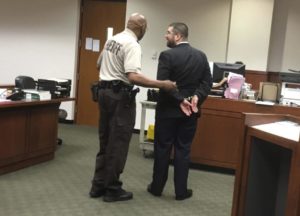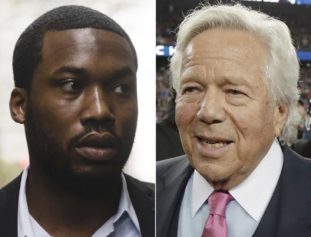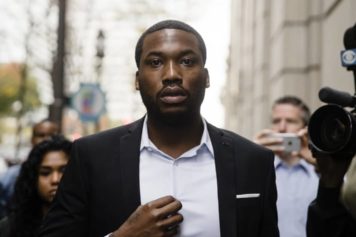
White nationalist Matthew Heimbach is led away in handcuffs on Tuesday, May 15, 2018 in Louisville, Kentucky, after a judge ruled that he violated the probation he was serving for physically harassing a protester at a 2016 Donald Trump campaign rally. Heimbach was arrested in March on battery charges after a domestic incident in Paoli, Indiana. (AP Photo/Dylan Lovan)
LOUISVILLE, Ky. (AP) — Led from a courtroom in handcuffs Tuesday, one of the nation’s most recognizable white nationalists will have 38 days behind bars to ponder the dizzying demise of the group he led before his arrest exposed a bizarre sex scandal.
Matthew Heimbach’s jail sentence for a probation violation is just the latest setback for the “alt-right” fringe movement that appears to be reeling after becoming emboldened and energized by Donald Trump’s presidential campaign and election.
Richard Spencer, who coined the term “alt-right” to describe a loosely connected band of white nationalists, neo-Nazis and other far-right extremists, suspended a college tour after violent clashes overshadowed one of his campus speeches in March. He and other leading alt-right figures are fighting lawsuits without help from lawyers. Many also are struggling to raise money or spread their messages after losing access to mainstream internet platforms. A few have even dropped out of the movement altogether.
And then there’s Heimbach, whose Traditionalist Worker Party was rocked by his arrest in March on charges he assaulted his wife’s stepfather, David Matthew Parrott, who also was the group’s spokesman. The men had argued over Heimbach’s alleged affair with Parrott’s wife, according to court documents. The alleged assault was a violation of Heimbach’s probation for a case in which he was accused of physically harassing a protester at a 2016 Trump campaign rally in Kentucky.
The Daily Stormer, a leading neo-Nazi website, has struggled to stay online since its founder, Andrew Anglin, published a post mocking the woman who was killed by a car that plowed into a crowd of counter-protesters at a “Unite the Right” white nationalist rally in Charlottesville, Virginia, last summer.
Anglin complained of being “banned from the internet” after domain-name registration companies Google and GoDaddy yanked the site’s web address, effectively making it unreachable. Other technology companies cracked down on far-right extremists in the rally’s aftermath. Twitter, for instance, banned accounts belonging to alt-right troll Tim “Baked Alaska” Gionet and white nationalist Jared Taylor.
Christopher Cantwell, a white nationalist who hosts a live-streamed talk show called “Radical Agenda,” was jailed on felony charges stemming from a torch-lit march through the University of Virginia’s campus on the eve of the rally. Cantwell, Spencer and other “Unite the Right” participants are named in a federal lawsuit that blames them for the Charlottesville violence.
White nationalists rejoiced when Trump seemed to spread the blame for the violence. But infighting quickly eroded the fragile alliance between alt-right factions.
White nationalist Brad Griffin, who has promoted the alt-right on his website, Occidental Dissent, said the Charlottesville rally became a catalyst for the movement’s “implosion.”
In October, Griffin helped organize a rally in Shelbyville, Tennessee, that fueled an internal debate over the “optics” of such events. Several leading alt-right figures mocked and criticized the rally’s participants for displaying neo-Nazi symbols and making “Sieg heil” salutes.
“The divisions were always there,” Griffin said. “There is a big class divide in the movement. There’s a certain faction of the alt-right that is more middle class, suburban, who are very dismissive of working-class people.”
Oren Segal, director of the Anti-Defamation League’s Center on Extremism, said some alt-right groups remain active despite the movement’s troubles, and have even attracted a new generation.
“These new members are not all of a sudden rejecting the hatred just because their leaders are fighting with each other,” he said. “Infighting is nothing new in the white supremacist movement.”
More than two years ago, Michigan attorney Kyle Bristow founded a self-described “alt-right” nonprofit group called the Foundation for the Marketplace of Ideas. Bristow filed federal lawsuits to clear a path for Spencer to speak at Michigan State University, Ohio State University and the University of Cincinnati.
But in March, two days before Spencer’s speech at Michigan State, Bristow abruptly announced that he was leaving his nonprofit and would “withdraw from politics.” Bristow said his organizing efforts felt increasingly “futile” in the face of opposition from anti-fascist protesters, “big business,” government officials and higher-education leaders.
During an interview this week, Bristow referred to the alt-right movement in the past tense. “Culturally, it rose very quickly. It collapsed very quickly. Who knows? Maybe it’s leaner and meaner now,” he said.
Spencer has lost other key allies since Charlottesville. Eli Mosley, who helped organize last August’s rally, disappeared from the alt-right scene after the New York Times uncovered evidence that he lied about his military service.
Spencer suspended his college tour after clashes between white nationalists and protesters overshadowed his sparsely attended speech at Michigan State. He claims the violence has dissuaded many “normal people” from attending his speeches, and he accuses university officials of stifling free speech.
“I don’t want to sound like a nerd, but the Empire struck back and figured out ways of scuttling what we were doing,” he said. “I’ll be back.”
Ryan Lenz, a senior investigative reporter for the Southern Poverty Law Center, which tracks domestic extremist groups, said the movement’s future is murky.
“Normally, with these power vacuums and leadership voids, someone tries to step up. We haven’t seen that yet,” Lenz said.


